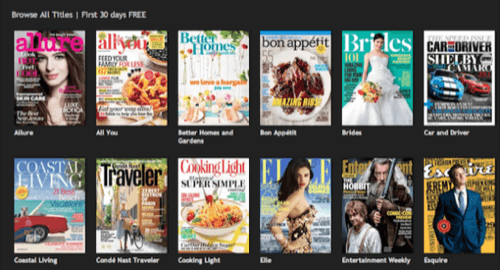
All-you-can-read magazine subscription service Next Issue landed on iOS this week. After seeing mixed results with the iPad to date, traditional publishers are eager to learn whether this Netflix-style model can propel them into the digital future. There’s a chance – if the smorgasbord approach can overcome three problems.
The idea certainly has its merits. If consumers pay for music in bulk with Spotify and fork over $8 per month for Hulu Plus, why wouldn’t they do the same for magazine journalism? The model may prove itself in time, but there are a few immediate challenges it faces at launch.
1. Limited Selection
Perhaps it’s rude to pick on Next Issue this early in its history, but from the standpoint of many consumers, its relative dearth of titles is a deal killer. Impressively, it has managed to sign up big-name publishers such as Conde Nast, Hearst and Time Inc. The result is a digital newsstand containing just fewer than 40 popular titles.
That’s not bad, but it’s still not nearly enough. Time. Glamour. Golf Digest. Wired. Browsing Next Issue’s digital shelves feels a bit like perusing the most generic airport newsstand you’ve ever seen. Some doctor’s offices have more variety. There aren’t any niche titles. No independent magazines. In the technology category, for example, we get Wired and Popular Mechanics. That’s it.
The audience’s content tastes have become more specific than ever in the Digital Age. On the Internet, we can read articles from just about any newspaper or magazine on the planet, give or take the occasional paywalled operation. Granted, this content cornucopia doesn’t lend itself to the kind of media brand loyalty that leads readers to pick a specific magazine from a newsstand full of titles. But it has trained us to seek content that is more specific to our interests and tastes.
We’ve also been conditioned to expect access to that content without paying for it. This is exactly the problem that publishers are struggling to address via tablets and, indeed, Next Issue itself. The basic plan for this service costs $120 per year. Assuming the average magazine subscription costs, let’s say, $20 per year, that means to be worth the fee, Next Issue must include at least six titles that a given subscriber is likely to read on a monthly basis. For many readers, that’s just not likely to be the case. Not yet, anyway.
2. Print-Centric Design
One common complaint about the tablet-specific editions published by magazines is that they’re too analogous to the experience of reading the print version and don’t take full advantage of the digital possibilities.
Things have evolved since the iPad launched in 2010, but in many cases, digital magazines are still little more than glorified PDFs. Some Conde Nast titles do a nice job of adding interactive bells and whistles, but don’t go far enough to clean up their print layouts and mold them to fit the tablet form factor.
The good news for media companies is that study after study has shown that people love reading on their tablets. Publishers had a hunch that this would be the case; that’s why they got so excited about the iPad before it even launched.
Readers are not, however, enamored of digital newsstands like Apple’s Newsstand, according to one recent survey. Rather, they prefer to read on the mobile Web and, to a lesser extent, via stand-alone publication-specific apps, many of which still have some digital growing up to do.
3. Content Overload
I don’t know about you, but my Instapaper queue is completely out of control. As a technology writer, I may have reading habits that are outside the norm, but I suspect I’m not the only person who finds it hard to squeeze in everything I want to read in a given week. With Instapaper, Flipboard, Reeder and Wired (to which I subscribe), it’s nearly impossible to keep up with everything. Don’t even get me started on the Kindle app, where a virtual shelf of books patiently waits for me to purge my never-ending queue of news and magazine articles.
The idea of gaining access to dozens of magazines sounds appealing. But for those of us with massive information appetites, how feasible is it that we’ll be able to make the experience worth $10-15 per month?
Of course, it’s still very early in this particular game. If the selection grows and digital magazines continue to mature, an option like this might catch on with consumers. If the financial model works out, it could help publishers build a stable bridge to the future – before print revenue hits rock bottom.





















